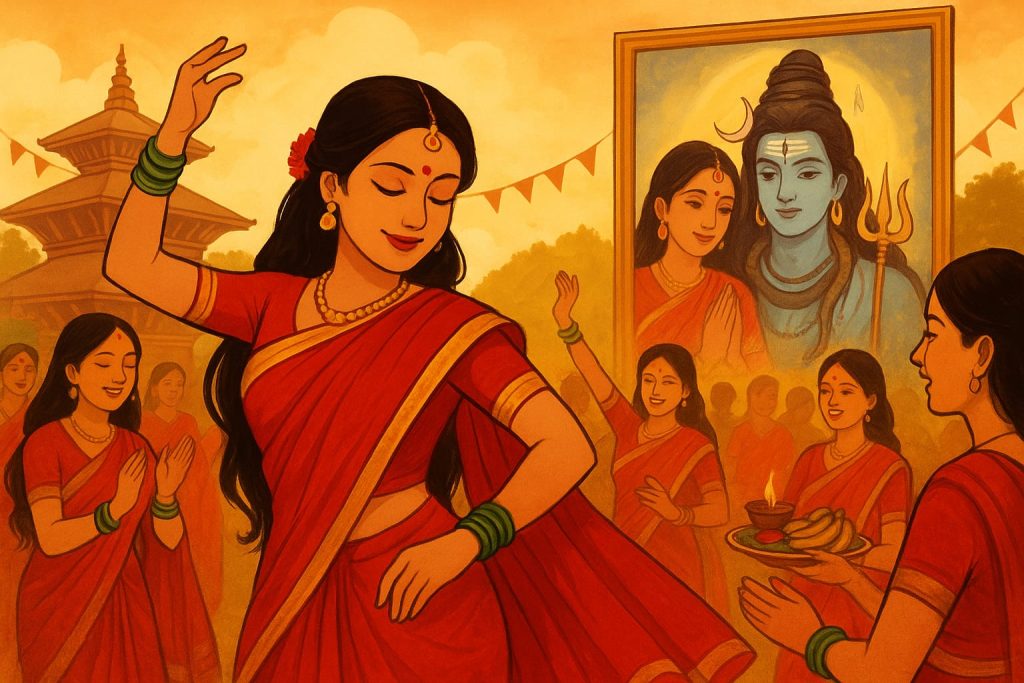Festivals are more than rituals; they are living stories passed down through generations, binding communities with culture, devotion, and shared memories. Among such festivals, Teej stands out as one of the most vibrant and emotionally significant celebrations in Nepal and parts of India. It is not merely a day of fasting or dancing in red saris—it is a celebration of womanhood, faith, and the eternal bond of marriage. To understand Teej fully, we must explore the questions of when, what, why, who, and where—and, of course, the deep-rooted beliefs and stories behind it.
What is Teej?
Teej is a Hindu festival primarily celebrated by women. It symbolizes devotion to Lord Shiva and Goddess Parvati, representing marital harmony, the well-being of husbands, and the blessing of prosperous family life. The festival is marked by fasting, prayers, singing, and dancing, but at its heart, Teej is a spiritual vow taken with utmost dedication.
Women, dressed in bright red saris, green bangles, and adorned with henna, gather together to celebrate. The sight of women dancing and singing folk songs while maintaining a day-long fast—sometimes even without a drop of water—is one of the defining images of Teej.
When is Teej Celebrated?
Teej falls during the Hindu month of Bhadra (August–September in the Gregorian calendar). The festival is not a single-day affair but a series of events that usually last three days, each holding unique significance:
- Dar Khane Din (The Feast Day): A day before the strict fasting, women gather to enjoy a lavish feast prepared by family members. It is a day of indulgence, laughter, and camaraderie, as women eat heartily—believing it will give them strength for the demanding fast the next day.
- Nirjala Brata (Fasting Day): On the main day of Teej, women observe a strict fast, often abstaining from both food and water. They pray to Lord Shiva for the well-being of their husbands and families—or, for unmarried women, for a loving husband in the future. Singing and dancing become spiritual expressions of devotion during this day.
- Rishi Panchami (Purification Ritual): The final day is dedicated to cleansing rituals. Women bathe with special leaves, perform prayers, and symbolically purify themselves from sins. This day emphasizes spiritual renewal and balance.
Why is Teej Celebrated?
The roots of Teej go back to ancient mythology and the timeless story of Goddess Parvati’s devotion to Lord Shiva. According to Hindu belief, Parvati was determined to marry Shiva—the great ascetic god who lived in meditation in the Himalayas. To win his heart, she performed severe penance for years, enduring hardships and fasting with unwavering devotion.
Moved by her dedication, Lord Shiva finally accepted her as his eternal consort. Their union represents the ideal of marital love, mutual respect, and spiritual connection.
Thus, Teej is celebrated by women to:
- Honor Parvati’s devotion and determination.
- Pray for the longevity and prosperity of their husbands.
- Ask blessings for marital happiness and family harmony.
- For unmarried women, it is a wish for a loving and caring partner, just as Parvati found in Shiva.
Beyond religious devotion, Teej also embodies women’s resilience. The act of fasting without water, while singing and dancing joyfully, showcases inner strength, patience, and faith.
Who Celebrates Teej?
Teej is celebrated mainly by Hindu women, but its significance has transcended beyond religion into culture and tradition.
- Married women: They fast and pray for the health, longevity, and prosperity of their husbands.
- Unmarried women: They participate with the hope of finding a loving husband.
- Widows and single women: In modern times, many also join the festivities, not always strictly for religious reasons, but as part of cultural expression and community bonding.
Teej is more than a family festival—it is also a social gathering for women. In societies where women often carry heavy responsibilities, Teej offers a rare opportunity for them to come together, celebrate, and express themselves through song and dance.
Where is Teej Celebrated?
Teej is most prominently observed in:
- Nepal: Here, Teej is one of the most significant festivals for women. Temples of Lord Shiva, especially the Pashupatinath Temple in Kathmandu, become central hubs of prayer and rituals. Thousands of women in red saris can be seen waiting patiently to offer their prayers.
- India: Teej is celebrated in several states, including Rajasthan, Bihar, Haryana, and Uttar Pradesh. While customs vary, the themes of devotion to Shiva and Parvati remain central.
- Worldwide: With the spread of South Asian communities across the globe, Teej is now observed in countries like the USA, UK, Australia, and the Middle East, where women gather to celebrate together, keeping traditions alive far from home.
The Beliefs and Symbolism of Teej
Teej is woven with deep symbolic meanings:
- Red Attire: The red saris symbolize love, passion, and marital happiness. Green bangles and ornaments represent fertility and prosperity.
- Fasting (Brata): It is believed that a woman’s sincere fasting and prayers during Teej can remove past sins, bless her family, and even influence her destiny.
- Songs and Dances: The traditional Teej songs are not just joyful expressions; they often contain hidden messages—about women’s struggles, desires, and hopes. In many villages, these songs have become a voice for women’s collective identity.
- Purification Rituals: The bathing and cleansing on Rishi Panchami signify spiritual renewal, showing the balance between devotion and self-care.
Teej in the Modern Context
While the religious roots remain strong, Teej has also evolved with time. Today, it is both a religious vow and a cultural festival.
In cities, women organize Teej gatherings, stage programs, and cultural shows. Social media floods with pictures of women in red attire, celebrating not just devotion but also sisterhood. Many also see Teej as a platform for women’s empowerment, where their unity and resilience are expressed through music, laughter, and rituals.
At the same time, debates have emerged about the rigidity of fasting and the health risks of Nirjala Brata (fasting without water). Some women now choose to follow symbolic fasts rather than extreme ones, blending tradition with practicality.
The Story of Teej: A Thread Between Past and Present
At its heart, Teej is the story of Goddess Parvati’s determination and the timeless belief that devotion and patience can move even the greatest forces of the universe. For women, it has become not only about seeking blessings for their families but also about celebrating their identity, resilience, and shared cultural heritage.
Whether it is the grandeur of Pashupatinath Temple in Kathmandu or the colorful streets of Jaipur, the essence of Teej is the same: faith, devotion, love, and the power of womanhood.
Conclusion
✨ Teej is not just a festival. It is a story of devotion, an echo of myth, a celebration of womanhood, and a reminder that traditions can be both sacred and joyful.



